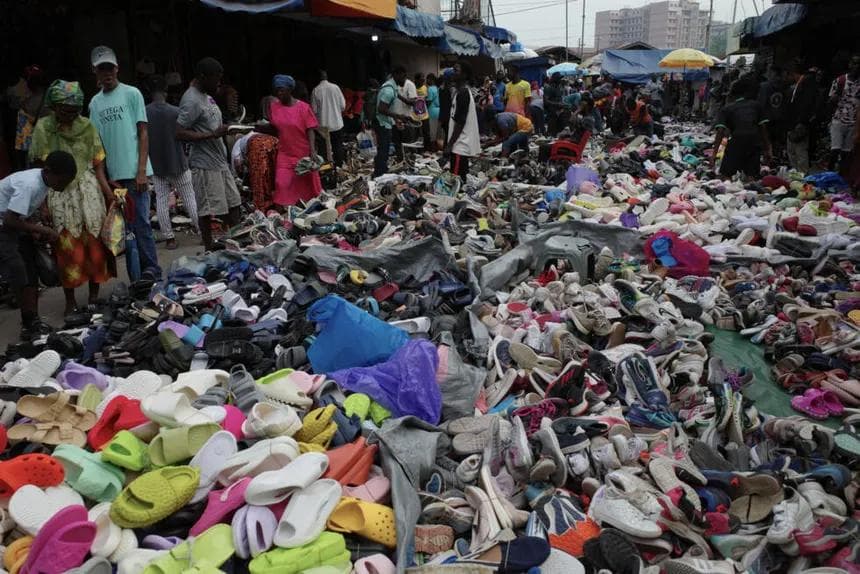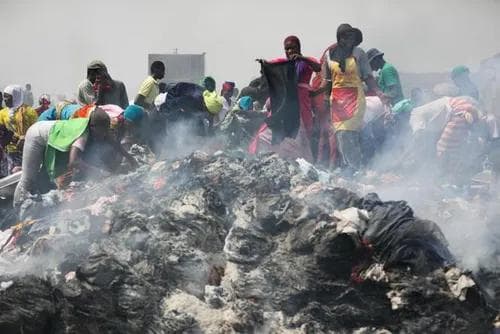African Fashion History
9 mins read
The Dilemma of Secondhand Fashion in Africa
By Joy Oshiokenoya
September 24, 2025
Secondhand fashion in Africa offers affordability and waste reduction but threatens local textiles. Explore its history, impact, and future.

In Africa, secondhand fashion is affordable and makes for more individuality for the wearer. But at what cost? | Photo: Modern Ghana.
“How do I embrace sustainable fashion as someone who loves shopping?”`
When people ask me that question, buying secondhand is always my go-to answer. It is a simple way to give clothes a new life and keep them from going to waste.
In many parts of the world, thrifting is celebrated as a win for both the environment and as it is affordable. But in Africa, the story isn’t so straightforward. For decades, bales of used clothing from the Global North have flooded local markets. To some, these imports mean access to quality clothing at cheaper prices. But to others, they represent one of the biggest threats to local fashion, creativity, and economic independence.
Fashion designer Sandra Tuboberreni captured this tension powerfully in a reflection she shared on Instagram after speaking at the Phygital Sustainability Expo on World Environment Day.
“I was honoured to speak on sustainability because no one does sustainable fashion like we [Africans] do. Our couture process is slow by design, intentional, purposeful, and people-led. Our craftsmen are custodians of generational knowledge. Our systems are rooted in heritage, not haste,” she wrote.
But her words quickly shifted to frustration, highlighting how African designers are sidelined in global conversations while their work is overshadowed by the flood of secondhand fashion.
“Yet we are rarely seen at the forefront of this global conversation or invited late, if at all. Instead, we are buried beneath piles of secondhand clothing, the thrift, the Okirika, or as my Port Harcourt people called it back then, the bend-down-select, dumped here by systems we did not design.”
For Tuboberreni, secondhand shopping is not sustainability but one of the biggest threats to local designers, fashion houses and entire industries. It undercuts creativity, jobs, and the future of fashion in Africa. But her concerns aren’t just philosophical; they’re backed by data.

Sandra Tuboberreni (far left), at the 2025 Phygital Sustainability Expo in Italy | Instagram.
In Ghana, roughly 15 million used garments arrive every week, yet as many as 40% are of such poor quality that they are unwearable. At Accra’s Kantamanto market alone, about 100 tonnes of clothing are discarded every single day. This waste piles up in landfills, blocks drainage systems, and often washes into the ocean.
Similar stories are found in East Africa, where 30 to 40% of imports are unfit for use. This declining quality squeezes profit margins, increases waste disposal costs, and places enormous pressure on the secondhand marketers whose livelihoods depend on the trade.
To make sense of this dilemma, we can’t only look at the present situation. We should ask how it all began. And the truth is, the secondhand trade in Africa is rooted in history as much as it is in economics and culture.
A Brief History of Secondhand Fashion in Africa
Across Africa, secondhand clothing is deeply embedded in daily life, and it goes by many names. Nigerians call it Okirika or bend-down-select, Kenyans say Mitumba, and in Ghana, it’s Obroni Wawu, meaning “clothes of the dead white man.” The names may differ, but the love-hate relationship is all the same.
During colonial times, Western-style clothing became linked with modernity and respectability. To secure white-collar jobs in banks, schools, and government offices, Africans were expected to wear European suits and dresses. Indigenous textiles like Adire, Aso Oke, and Kente never lost cultural importance, but they were pushed into the background of daily life. This shift planted the idea that Western clothing was the standard of professionalism, a perception that still lingers today.
Then came the 1980s and 1990s. Economic crises led many African governments to adopt Structural Adjustment Programmes (SAPs) backed by the IMF and World Bank. These programs aimed to stabilise economies by reducing government spending, liberalising trade, and opening markets to foreign goods. In practice, they stripped away protections that had once supported local industries like subsidies, price supports, and import licensing.
To put this into perspective, Ghana’s textile industry lost almost half of its output between 1975 and 2000. In Nigeria, the industry employed more than 600,000 people in the 1980s, but by the early 2000s, it had withered down to a shadow of itself. The number of factories dropped from 125 in the early ’90s to fewer than 40 by 2010. Zambia wasn’t spared either. What used to be about 25,000 textile jobs in the 1980s had dwindled to under 10,000 by 2002.

Investopedia.
With local industries collapsing, secondhand clothing slowly began to take hold. It was a trickle at first, arriving through donations, missionary groups, and small-scale imports. But as factories shut their doors and production dwindled, the trickle became a flood. By the 1990s, bales of used clothes from the Global North were landing in ports and markets across the continent.
For many households, these imports offered a cheaper alternative to the rising costs of locally made garments. And as Western styles became tied to ideas of professionalism and modernity, secondhand clothing was not just accessible, it was desirable. Yet, while markets grew busier with the cheaper alternative, the decline of local textile industries and the relegation of indigenous styles created a cultural and economic loss that was impossible to ignore.
The Present-Day Dilemma
I remember my own first encounter with this necessity. In 2017, I had just gotten a teaching job, and I needed skirts and shirts, the kind of clothes people expect you to wear in a white-collar work environment. New ones were out of the question as they were far above my budget. So I resorted to the secondhand market.
I can still picture myself running alongside my mum through Katangua Market in Lagos, dodging traders shouting, “Na mumu dey go boutique.” Roughly translated, it means “only a fool shops at boutiques.” And honestly, who can argue with this logic?
My experience was not unique. For generations, secondhand clothing has given people a way to dress with dignity, access work, and participate in style cultures they might otherwise be excluded from. For many, it has been the only affordable entry point into fashion.
The Decline in Quality
Aside from affordability, when people talk about secondhand fashion, they suggest that it is also for the sake of sustainability. Every item that is reused extends its life, reduces textile waste, and delays the need for new production.
In Africa, where waste systems are already stretched thin, this practice carries real weight. Globally, the secondhand clothing market is valued at over $190 billion as of 2024, and it is projected to almost double by 2027. Africa plays a large role in this trade. According to Fashion Revolution, around 70% of clothing donated in Europe ends up in Africa. On the surface, this looks like an opportunity to supply affordable clothing for millions of households while also reducing global waste.
Yet the reality is more complicated. The secondhand clothes entering African markets today are not the same as those of the past. Garments were produced with durability in mind. A secondhand cotton shirt or a wool blazer could last years.
Today, the rise of fast fashion has changed that. Clothes are churned out cheaply and quickly, often made from synthetic fibres that lose shape or tear after only a few washes.
The result is that between 30 to 40% of secondhand clothing imports to Africa are unwearable. In Ghana’s Kantamanto market alone, about 100 tonnes of textile waste are discarded every single day. This seemingly great sustainable option now comes at some pretty big environmental costs.

A landfill where secondhand clothes are being destroyed | lemonade.fr.
And there is another layer. Sellers often buy their bales of clothing on credit, hoping to make enough profit to repay loans. When a large portion of those bales turns out to be unsellable, it is not the exporters in Europe or North America who bear the loss. It is the African traders—many of them women—whose livelihoods depend on the market.
To Ban or Not to Ban?
Due to these challenges, some governments have attempted to ban secondhand clothing imports altogether. Rwanda is one example, raising tariffs and moving toward a full phase-out. Uganda also supported the East African Community’s plan to end imports by 2019. Nigeria, too, has a long-standing ban on the importation of used clothes under its customs law, although in practice the trade continues through smuggling and weak law enforcement.
But these restrictions fuel smuggling networks while doing little to revive the struggling textile industries. Countries lose potential tax revenue, and the lack of regulation makes it easier for low-quality textile waste to slip through unnoticed.
But what if the bans were enforced strictly? The consequences would be severe. The secondhand trade employs millions of Africans. In Ghana alone, the Kantamanto market provides jobs for about 30,000 people, most of them women. Across the continent, the industry is estimated to employ more than 2.5 million people. Shutting it down would mean stripping away a vital source of income, especially for women who already face limited economic opportunities.
The Affordability Problem
There is also the question of affordability. Sustainable fashion brands, while essential, are expensive. Producing ethically means paying fair wages, sourcing eco-friendly fabrics, and avoiding mass production. All of this raises the cost. For most Africans, these brands are not realistic everyday options.
If secondhand clothing disappears, where will people turn? The answer is simple: fast fashion. The same fast fashion brands that are driving overproduction and filling landfills worldwide. This creates a paradox.
In trying to protect local industries by banning secondhand, governments risk pushing consumers into buying more fast fashion, which produces even lower-quality clothes and far more waste.
Towards a Better Solution
So what’s the way forward? Outright bans are not the answer, as they often hurt the very people they aim to protect.
Instead, governments could regulate imports more strictly. Customs duties, quality checks at the border, and accountability measures for exporters could ensure that only wearable clothes make it through. That would protect sellers from losses and reduce environmental strains.
Alongside regulation, real investment is needed in Africa’s textile industries. Reviving textile mills, supporting small-scale weavers, and making indigenous fabrics more accessible would create sustainable and affordable alternatives while restoring pride in African fashion.
When someone asks, “How do I embrace sustainable fashion as someone who loves shopping?” My answer still includes buying secondhand. But in Africa, that answer comes with an asterisk.
Secondhand fashion in Africa is not a simple story of good or bad. It is survival for millions, a source of affordable clothing, and even a way of extending the life of garments that might otherwise be wasted. At the same time, it’s also a system that, without reform, threatens the very future of African fashion.
The challenge isn’t choosing between secondhand and local fashion, but finding a way to make both coexist in a system that values people, heritage, and the environment.
Like Post
Comments
Ochuko
9/24/2025Such an insightful take on this issue! I really enjoyed reading this piece 👏🏾👏🏾
Related Posts
MoreRita Idehai, on Waste, Work, and Driving Social Impact in Nigeria
Through Ecobarter and its fashion arm, Wrep, Rita Idehai is transforming plastic waste into fabric, and creating new pathways for women and communities to thrive.
Miss Green Fashion ‘25: Celebrating Beauty, Sustainability, and Impact
Miss Green Fashion is redefining beauty with purpose, promoting sustainability, creativity, and women’s empowerment.
10 Sustainable Fashion Habits You Can Start Today
We highlight 10 simple everyday habits to make your fashion choices more sustainable, from rewearing and repairing to thrifting and supporting local artisans.
The Hidden Plastics in Our Clothes
Much of our clothing is made from plastic-based fabrics like polyester and nylon. Learn their impact and how to choose more sustainable options.